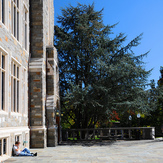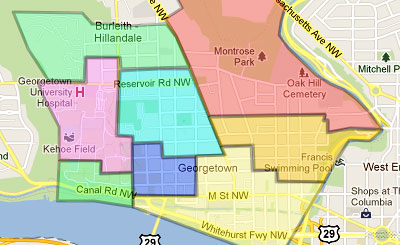Georgetown ANC redistricting plan marginalizes students

Photo by Serge Melki on Flickr.
A redistricting plan proposed for Georgetown’s ANC 2E would dramatically under-represent students attending Georgetown University. The proposal is a direct attempt to limit student involvement in neighborhood affairs.
Yesterday, the Advisory Neighborhood Commission 2E redistricting task force adopted a redistricting plan proposed by the group’s co-chairs, on a vote of 9 to 6. The proposal will be subject to community comment at ANC 2E’s next public meeting before it can become a final recommendation.
The proposal represents an affront to DC’s redistricting code, will minimize the political participation of Georgetown students in local government, and demonstrates major problems with the ANC redistricting process.
The plan as proposed by ANC 2E chair Ron Lewis, Citizens Association of Georgetown President Jennifer Altemus, and Burleith Citizens Association President Lenore Rubino, would split ANC 2E into eight single-member districts (SMDs), and would pack all Georgetown University students living in university-owned properties (both those within the University’s gates and those off-campus) into two huge SMDs.
This addition of an 8th SMD to an ANC which has historically had only 7 comes in response to a boom in Georgetown’s population and the addition of 800 undergraduates to GU’s campus. Most of the new GU residents live within the Southwest Quadrangle, a building that opened in 2003 and caused SMD 2E04, which I currently represent, to swell in size to become the city’s third largest.
While an improvement over the current ANC 2E map, which blatantly gerrymanders the university campus into four separate SMDs, the co-chair’s plan is still problematic.
Under §1-1332 of the DC Code,
(e) No redistricting plan or proposed amendment to a redistricting plan shall result in district populations with a deviation range greater than 10% or a relative deviation greater than plus-or-minus 5%, unless the deviation results from the limitations of census geography or from the promotion of a rational public policy, including, but not limited to, respect for the political geography of the District, the natural geography of the District, neighborhood cohesiveness, or the development of compact and contiguous districts.
A memo released by DC Council members Michael Brown and Jack Evans on the 2010 redistricting process goes further, telling task force participants that “each single-member district shall have a population of approximately 2,000 people, and shall be as nearly equal as possible.”
The co-chair’s plan clearly does not adhere to this guidance. It packs unacceptably large numbers of students into a small number of SMDs, while spreading the non-student population around into several unacceptably small SMDs.
The two packed campus districts would each have exactly 2,581 individuals in them, while SMD 2E01 would have a population of 2,409. Meanwhile, SMD 2E02 (Commissioner Lewis’) would have a population of only 1,660, SMD 2E03 a population of only 1,705, SMD 2E05 a population of 1,710 and SMD 2E06 a population of 1,836. Only SMD 2E07, at 1,983 individuals, would be within the size variance advised under code.
The SMD divisions proposed appear to be a blatant attempt to restrict the political power of students, and enhance the power of non-students.
The co-chairs and their supporters have argued that the “neighborhood cohesiveness” exception within the code makes their plan admissible. Such an interruption is without precedent. According to information provided by the Office of Planning, following the 2001 redistricting process only eight SMDs were outside the 1,800-2,200 population range at that time, with the largest being SMD 6B11 at 2,362 people. For ANC 2E to have six such “exceptional districts,” and two districts far larger than the largest from 2001 is extraordinary.
More to the point, the purpose of this size variance seems clear: to ensure that students continue to be under-represented on ANC 2E. This is troublesome considering that section §1-1332 on the DC Code continues:
(f) No redistricting plan or proposed amendment to a redistricting plan shall be considered if the plan or amendment has the purpose and effect of diluting the voting strength of minority citizens.
What exactly constitutes “minority citizens” is not made clear, but students certainly are a statistical minority in the District of Columbia, and the DC Human Rights Act includes students as a protected class. Regardless of legal status, though, it is unfortunate that the redistricting task force would move to pack students.
Students live in DC for a majority of the year, pay sales and income tax here, and are greatly affected by the actions of DC government. The fact that some students, for fairly obvious reasons, choose not to register to vote in DC is ignoratio elenchi. Voting status simply has no relevance to ANC districting. For example, DC’s Central Detention Facility famously has its own SMD.
A far better option for ANC 2E redistricting was put forward by student John Flanagan. The Flanagan proposal would, like the co-chair’s proposal, create two on-campus districts. Unlike the co-chair’s proposal, it would create a third, mixed district that would be potentially winnable for both students and non-students. Flanagan’s plan drew support from both students and non-students on the task force.
The existence of a mixed district such as that proposed by Flanagan would add motivation for students to be actively involved in local politics. It would also create incentive for whoever held the seat to balance the concerns of students and non-students alike. This would promote cooperation and encourage students to take increased responsibility for their actions in the community.
Additionally, the Flanagan proposal has the advantage of adhering to the DC Code. No district in his plan falls outside the 1,800-2,200 range, and the difference between the largest and smallest district is only 214 people. Compared to the 921 person difference in the co-chair’s plan, Flanagan’s is much more even.
The co-chairs, in their official report (PDF), dismissed the Flanagan proposal, writing that it is “a mechanical approach driven by a faulty premise — that there should be three student SMDs — and flawed by insufficient ground-level research and inquiry.”
It is disappointing that the co-chairs would imply that a third student commissioner would be objectionable. ANC 2E passed a Student Bill of Rights in 2002 affirming the the right of students to “full participation in community and civic affairs.” The ANC is bound by its own rules to give student votes as much weight as non-student ones.
Disappointment in this process extends beyond the co-chairs to include Jack Evans, for the manner in which he chose to conduct ANC 2E’s redistricting. The selection process for task force co-chairs was done without public input. That led to the task force having no student co-chair, despite the fact that Georgetown students represent nearly 45% of ANC 2E’s population.
Moreover, Mr. Evans decided to separate the Ward 2 redistricting task force into ANC sub-groups, while other wards have met as a whole. That has allowed the Ward 2 process to be bogged down in hyper-local concerns, absent the moderating voice of more faraway median voters.
Residents of ANC 2E should consider speaking out against the co-chairs’ proposal, and in favor of Flanagan’s. ANC 2E will present the co-chair’s plan at its next meeting, on August 29th at 6:30 pm in Georgetown Visitation’s Heritage Room. Ron Lewis can be contacted at Ron.Lewis@anc.dc.gov.


